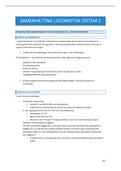Locomotor 2 Guides d'étude, Notes de cours & Résumés
Vous recherchez les meilleurs guides d'étude, notes d'étude et résumés sur Locomotor 2 ? Sur cette page, vous trouverez 250 documents pour vous aider à réviser pour Locomotor 2.
Page 3 sur 250 résultats
Trier par
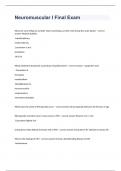
-
Neuromuscular I Final Exam questions with answers 2024
- Examen • 47 pages • 2024
-
Disponible en pack
-
- €18,43
- + en savoir plus
Neuromuscular I Final ExamWhat are some things to consider when examining a pt with a SCI during the acute phase? - correct answer Medical Stability Interdisciplinary needs/referrals Locomotor vs w/c propulsion W/C Rx Whats addresesd during the acute phase of guillian Barre? - correct answer - Supportive Care - Prevention of Secondary complications -Rehabilitation for recovery and/or compensatory movement strategies When does the onset of MS typically occur? - correct answe...
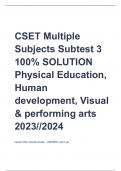
-
CSET Multiple Subjects Subtest 3 100% SOLUTION Physical Education, Human development, Visual & performing arts 2023//2024
- Examen • 28 pages • 2024
-
Disponible en pack
-
- €12,90
- + en savoir plus
CSET Multiple Subjects Subtest 3 100% SOLUTION Physical Education, Human development, Visual & performing arts 2023//2024 Lesson Plan should include - ANSWER -warm up -instruction -activity -feedback Gross motor skills - ANSWER Abilities required to control large movements of the arms, legs, and feet, or the whole body -k-2 - these develop before fine motor skills EX: running, jumping, climbing, and throwing. Biomechanical principle - ANSWER -the forces governing the inter...

-
Texas Teachers 158 Practice Exam with complete solutions
- Examen • 34 pages • 2023
-
Disponible en pack
-
- €11,51
- + en savoir plus
Texas Teachers 158 Practice Exam with complete solutions When teaching motor skills to elementary students, the teacher must be aware that children A. develop faster through auditory instruction of new activities B. discover their own aptitudes and preferences for different activities. C. give preference to proprioceptive over visual feedback. D. respond similarly to various physical contexts and environments. - ANS ️️ B The development of a child's motor behavior starts with A. si...
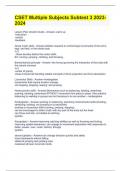
-
CSET Multiple Subjects Subtest 3 2023-2024
- Examen • 27 pages • 2024
-
Disponible en pack
-
- €15,20
- + en savoir plus
Lesson Plan should include - Answer--warm up -instruction -activity -feedback Gross motor skills - Answer-Abilities required to control large movements of the arms, legs, and feet, or the whole body -k-2 - these develop before fine motor skills EX: running, jumping, climbing, and throwing. Biomechanical principle - Answer--the forces governing the interaction of the body with the natural universe -k-2 -center of gravity -these include ball handling related concepts of force projec...
Samenvatting van het volledige vak locomotor system 2 in de 3e bachelor geneeskunde. Samenvatting van alle lessen. Behaald resultaat: 18/20
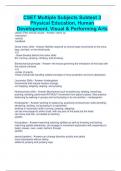
-
CSET Multiple Subjects Subtest 3 Physical Education, Human Development, Visual & Performing Arts
- Examen • 27 pages • 2023
-
- €12,43
- + en savoir plus
Lesson Plan should include - Answer--warm up -instruction -activity -feedback Gross motor skills - Answer-Abilities required to control large movements of the arms, legs, and feet, or the whole body -k-2 - these develop before fine motor skills EX: running, jumping, climbing, and throwing. Biomechanical principle - Answer--the forces governing the interaction of the body with the natural universe -k-2 -center of gravity -these include ball handling related concepts of force projecti...
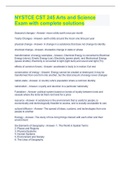
-
NYSTCE CST 245 Arts and Science Exam with complete solutions
- Examen • 7 pages • 2023
-
Disponible en pack
-
- €11,97
- 1x vendu
- + en savoir plus
Seasonal changes - Answer- moon orbits earth once per month Yearly Changes - Answer- earth orbits around the moon one time per year physical change - Answer- A change in a substance that does not change its identity chemical change - Answer- charastics change in state or phase transformation of energy examples - Answer- Chemical Energy is converted to Electrical Energy (stove), Kinetic Energy (car), Electricity (power plant), and Mechanical Energy (space shuttle). Electricity is conv...
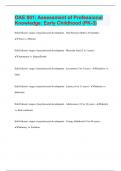
-
OAE 001: Assessment of Professional Knowledge: Early Childhood (PK-3)
- Examen • 20 pages • 2024
-
Disponible en pack
-
- €9,21
- + en savoir plus
OAE 001: Assessment of Professional Knowledge: Early Childhood (PK-3) Erik Erikson's stages of psychosocial development - Oral Sensory (birth to 18 months) - Trust vs. Mistrust Erik Erikson's stages of psychosocial development - Muscular Anal (2 to 3 years) - Autonomy vs. Shame/Doubt Erik Erikson's stages of psychosocial development - Locomotor (3 to 5 years) - Initiative vs. Guilt Erik Erikson's stages of psychosocial development - Latency (6 to 11 years) - Industry vs. Inf...
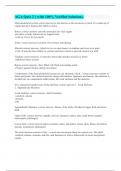
-
AGA Quiz 2 || with 100% Verified Solutions.
- Examen • 10 pages • 2024
-
Disponible en pack
-
- €10,13
- + en savoir plus
Musculoskeletal system correct answers is also known as the locomotor system. It is made up of organs that give humans the ability to move. Bones: correct answers -provide protection for vital organs -provides a sturdy framework to support body -work as a lever in movement Joints: correct answers Location of two bones articulating Muscles correct answers -Attach to two or more bones via tendons and cross over joint. -Cells of muscles have ability to contract and move bones to provid...
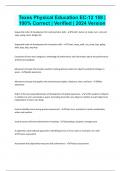
-
Texes Physical Education EC-12 158 | 100% Correct | Verified | 2024 Version
- Examen • 5 pages • 2024
-
Disponible en pack
-
- €7,36
- + en savoir plus
Sequential order of development for nonlocomotor skills - Stretch, bend, sit, shake, turn, rock and sway, swing, twist, dodge, fall Sequential order of development for locomotor skills - Crawl, creep, walk, run, jump, hop, gallop, slide, leap, skip, step-hop Comprised of two main categories: knowledge of performance and information about the performance - Extrinsic feedback Movement concept that involves students making decisions about an object's positional changes in space - Spatial aw...

Stress d'étude? Pour les vendeurs sur Stuvia, c'est en fait une époque dorée. KA-CHING ! Gagnez aussi de vos résumés et commencez à télécharger dès maintenant. Découvrez tout sur gagner de l'argent sur Stuvia

